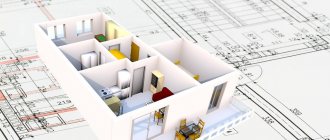What are these buildings?
The current legislation of the Russian Federation does not provide a clear explanation of the terms “purpose of premises” and “functional purpose of premises”.
Reference! According to sub. 3 clause 36 of block 3.5 of the procedure for maintaining the Unified State Register of Real Estate, approved by order of the Ministry of Economic Development of the Russian Federation dated December 16, 2015 No. 943, there is a division of all premises into two types: non-residential and residential.
The provisions of the Unified State Register determine the types of permitted use of a particular object. Previously, the functional purpose of a non-residential building was necessarily indicated in the design documentation. But at present, the Law “On Participation in Shared Construction” dated December 30, 2004 No. 214-FZ no longer contains a mandatory requirement to include in the information about a construction project information about the functional purpose of non-residential buildings that do not belong to common property.
The Civil and Housing Code of the Russian Federation, as well as Federal Law of the Russian Federation No. 218 dated July 13, 2015, provide the main criteria for non-residential premises, which also meet the requirements for a residential building, namely:
- The object must be immovable and isolated, its boundaries are the floor, ceiling, walls.
- There must be an entrance to such a building.
- The immovable nature of the object is due to the fact that it is part of a building located on a specific plot of land.
- It can also be located in residential and non-residential buildings, but the premises themselves must be classified as non-residential.
The main difference between a non-residential property and a residential one is that it does not provide for permanent residence of people, and also that it is allowed to be used only for administrative, public, commercial and other purposes.
Most citizens do not distinguish between the legal status of common property and non-residential premises. The entrance, attic, elevator and basement are considered common areas. Non-residential premises in apartment buildings include cafes, shops, offices and other organizations. A special place is occupied by domestic non-residential premises in which there are studios, shops, and social welfare institutions.
Administrative buildings are structures united by a common architectural task, the main purpose of which is to create conditions for the functioning of the administrative apparatus of state, municipal and private enterprises, institutions and organizations.
Signs
The main features are as follows:
- Materiality and isolation. Non-residential space, like an apartment, house or room, is a completely isolated object. It has its own walls, floor and ceiling, as well as an entrance.
- An object is real estate. According to Federal Law No. 122, the document distinguishes the right to state registration and to ownership of a particular premises.
- The real estate is part of a building (this is a common feature with living space).
- Property can be registered on a specific land area and cannot be moved.
- The premises are included in the non-residential stock. It is isolated, despite the fact that it may be located in a residential or non-residential building.
- The functional purpose is somewhat dual: the property is not intended for human habitation, but is suitable for doing business and being used for production purposes.
What are there, list
Let us define built-in, attached, and detached non-residential buildings.
Reference! The legal status of built-in and attached premises is determined by “SP 31-107-2004. Architectural and planning solutions for multi-apartment residential buildings" (approved and recommended for use by Letter of the State Construction Committee of the Russian Federation dated April 28, 2004 No. LB-131/9).
- The built-in non-residential premises are located within the dimensions of a residential building with a protrusion beyond its boundaries of no more than 1.5 m.
- An attached part is a part of a building located outside the contour of its main external walls, which is auxiliary to the building and has one (or more) common main wall with it.
- Built-in and attached is a non-residential premises that is located within the dimensions of a residential building and in volumes extended beyond the dimensions of a residential building by more than 1.5 m.
In Russian legislation, the term “detached building” is not clearly defined by regulations. In legal practice, this term refers to an architectural object that is not united with another building by a common foundation and communications.
What relates to buildings, their functional and purpose
The intended purpose of non-residential premises is determined by the activity for which it is intended.
Below is a classification by intended purpose:
- production;
- sports;
- warehouse;
- municipal and household;
- educational;
- trading;
- catering enterprises;
- medical;
- free appointment;
- office
The functional purpose of a building means the presence of design features and technical characteristics that allow it to be used as an independent building.
Based on their functional purpose, buildings are divided into the following groups:
- basic;
- technical;
- communication;
- auxiliary;
- serving.
How to change the purpose of the territory?
Many citizens ask the question: “How to change the purpose of non-residential premises?” Let’s figure it out.
If the new direction of activity does not entail drastic interventions in the layout and design of the premises, then changing the intended purpose of a non-residential property will not be particularly expensive in terms of time or money.
On his own initiative, the tenant is not given the right to change the intended purpose of the property, but only with the consent of the owner or on his instructions, executed by a notary.
For any type of activity, you will need to obtain approval in the form of a conclusion from the State Fire Inspectorate at the level of the district fire inspection department.
Next, it is important to obtain the opinion of Rospotrebnadzor, since this is the body in charge of the dignity. epid. permits, without paper from this body it is impossible to start operating a catering establishment, store, etc. You need to order plans for the rooms below and above from the BTI.
Even if the owner himself is completely sure that the premises are suitable and meet all the requirements of the Resolution of Ch. state rank doctor of the Russian Federation dated 09/07/2001 N 23, then his confidence means nothing without a document from Rospotrebnadzor specialists.
Then you should prepare:
- title papers for the property;
- registration certificate;
- explication, floor plans;
- certificate on the technical condition of the building structures (from the BTI);
- a recent document on inventory value (from the BTI);
- a paper from housing and communal services confirming that there are no debts to pay for utilities.
A package of documents with an application from the owner (or the tenant on his behalf) should be submitted to the District Prefecture. Having received a positive answer, you can adjust the purpose of the premises in the Unified State Register.
When starting activities in a new field, it is important not to forget to notify Rospotrebnadzor about this (Article 8 of Federal Law No. 294).
What other objects are not provided for permanent residence?
Non-residential premises - an architectural object or part of it, which, according to its intended purpose, is not intended for permanent residence of people. The belonging of an object to a specific type determines the exercise of the right to a structure and affects its civil legal status.
Based on their use for commercial and administrative purposes, the following varieties are distinguished:
- office;
- warehouse;
- hotel;
- garage;
- trading;
- industrial.
Attention! There is a classification of commercial real estate into classes from “A” to “D”, depending on the level of quality. Hotel real estate is divided into 14 separate classes.
There is a classification of non-residential objects according to their purpose:
- used to generate income (commercial);
- used to create conditions for generating income (industrial as well as industrial).
Non-residential premises for free use
There is a trick to expand the area of use of real estate by calling it non-residential premises for free use. What is this - non-residential premises for free use?
These are universal objects that can be used by tenants for various activity profiles, excluding special.
Free-use premises (hereinafter referred to as PSN) can have different areas, which, when placing offices or retail outlets, can be easily divided by installing prefabricated partitions and organizing the required number of compartments.
With PSN there are fewer problems when organizing your own business, they are easier to rent and sell, and the cost is much higher than with a specific connection to the purpose of operation.
There are many options for using PSN, but such premises cannot be called 100% universal; sometimes the specifics of the chosen area of operation will require additional approvals and re-registration.
Classification by type of permitted use
Non-residential premises are adapted for various types of activities. There are the following types of buildings according to types of permitted use:
- Retail space used for trading activities. This category of buildings does not always have permanent walls, and may also consist of a small number of retail areas. It is mandatory to have basic communications systems nearby such an area.
- Office , used to furnish an organization's office. The main features of offices are the presence of capital walls separating it from other buildings. A prerequisite for an office is the presence of communication systems directly in the office (water supply, bathroom).
- Universal , designed for various types of business activities (office, medical office, gym, beauty salon).
- Stock. It is characterized by the presence of solid walls separating it from other premises. The presence of a separate entrance and basic communications is not important.
- Separate premises. This category of buildings has a separate entrance and main walls that separate it from other architectural objects. Communications are a must.
Division into auxiliary and main
Non-residential premises can, depending on the possibility of independent use, be divided into main and auxiliary:
- The main premises are provided for the implementation of the main goals and objectives of the building, in which functional processes take place.
- An auxiliary premises, according to its functional purpose, serves one, several premises or the entire building and cannot be independently used by persons who are not the owners of the building or premises in this building.
This category refers to objects that are inextricably linked with the life support systems of the building. The purpose of auxiliary areas is to serve the main spaces.
In the Civil Code of the Russian Federation, the main and auxiliary objects of non-residential stock are considered in 2 options:
- in the form of a single complex thing (Article 134 of the Civil Code of the Russian Federation);
- in the form of the main thing and accessory (Article 135 of the Civil Code of the Russian Federation).





